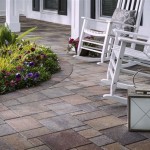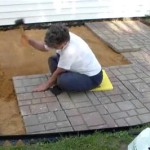How to Seal Your Outdoor Concrete Patio Floor
Concrete patios, while durable and versatile, are susceptible to damage from the elements. Unsealed concrete is porous, absorbing moisture, chemicals, and dirt, which can lead to cracking, staining, and deterioration over time. Sealing a concrete patio floor is a crucial step in protecting the investment and extending its lifespan while enhancing its aesthetic appeal. This article offers a comprehensive guide on how to properly seal an outdoor concrete patio floor, emphasizing preparation, sealant selection, and application techniques.
Assessing the Concrete and Choosing the Right Sealant
Before beginning any sealing project, a thorough assessment of the concrete surface is necessary. The condition of the concrete dictates the type of preparation required and the appropriate sealant to use. New concrete requires different treatment than old, stained, or previously sealed concrete.
New Concrete: Newly poured concrete needs to cure for at least 28 days before sealing. This curing period allows the concrete to fully harden and release excess moisture. Sealing concrete too soon can trap moisture, hindering proper curing and potentially causing issues like efflorescence (a white, powdery substance on the surface) or delamination (the peeling or flaking of the sealant).
Existing Concrete: Older concrete requires a close examination for cracks, stains, and previous sealant. Existing cracks need to be repaired before sealing, using a concrete crack filler appropriate for the size and type of crack. Stains, such as oil or rust, should be thoroughly cleaned with a concrete degreaser or rust remover. If the concrete has been previously sealed, the old sealant needs to be removed if it is peeling, flaking, or incompatible with the new sealant.
Choosing the Right Sealant: Selecting the appropriate sealant is crucial for long-term protection and aesthetic appeal. Several types of concrete sealants are available, each with unique properties and applications.
Acrylic Sealants: Acrylic sealants are water-based or solvent-based and offer good UV resistance and affordability. They provide a protective layer against water and some stains, but they are less durable than other options and may require more frequent reapplication. Acrylics are generally suitable for patios with light foot traffic and minimal exposure to harsh chemicals.
Epoxy Sealants: Epoxy sealants are known for their exceptional durability and chemical resistance. They create a hard, glossy finish that is resistant to abrasion, stains, and chemicals, making them suitable for high-traffic areas or patios prone to spills. Epoxy sealants typically require two-part mixing and careful application to avoid bubbling or uneven coverage. They are also generally more expensive than acrylic sealants and may not be ideal for outdoor applications where UV exposure is high, as they can yellow over time.
Polyurethane Sealants: Polyurethane sealants offer a balance of durability, flexibility, and UV resistance. They provide a tough, abrasion-resistant finish that can withstand heavy foot traffic and outdoor elements. Polyurethane sealants are available in water-based and solvent-based formulations, with water-based options being more environmentally friendly and easier to clean up. They are suitable for a wide range of outdoor concrete patios and offer excellent protection against weathering and stains.
Penetrating Sealants (Siloxanes and Silanes): Penetrating sealants, such as siloxanes and silanes, are designed to penetrate the concrete surface and create a water-repellent barrier from within. They do not form a surface film, which allows the concrete to breathe and reduces the risk of moisture buildup and delamination. Penetrating sealants are excellent for protecting against water damage, freeze-thaw cycles, and salt intrusion, but they do not provide the same level of stain resistance as film-forming sealants. They are often used as a primer or base coat before applying a film-forming sealant for added protection.
When selecting a sealant, it is important to consider factors such as the patio's exposure to the elements, the level of foot traffic, the desired finish (glossy, matte, or natural), and the budget. Reviewing the product specifications and manufacturer's recommendations is crucial to ensure compatibility with the concrete and the desired performance characteristics.
Preparing the Concrete Surface
Proper surface preparation is critical for achieving a successful and long-lasting sealant application. The concrete surface must be clean, dry, and free of any contaminants that could interfere with the sealant's adhesion. This process typically involves several steps:
Cleaning: Begin by removing any loose debris, dirt, and vegetation from the patio surface using a broom or leaf blower. For stubborn dirt or stains, use a pressure washer with a wide-angle nozzle to avoid damaging the concrete. If using a pressure washer, maintain a safe distance and consistent sweeping motion. For oil stains, apply a concrete degreaser according to the manufacturer's instructions, scrubbing thoroughly with a brush before rinsing.
Etching (if necessary): Etching the concrete opens the pores of the surface, allowing the sealant to penetrate and bond more effectively. This is particularly important for smooth or tightly troweled concrete. Etching can be accomplished using a muriatic acid solution or a concrete etching product. When using muriatic acid, always wear appropriate protective gear, including gloves, eye protection, and a respirator. Dilute the acid according to the manufacturer's instructions and apply it evenly to the concrete surface. Allow the acid to react for the recommended time, then thoroughly rinse the surface with water and neutralize it with a solution of baking soda and water. Alternatively, use a concrete etching product that is designed for this purpose, following the manufacturer’s instructions carefully.
Repairing Cracks and Damage: Before sealing, all cracks and damaged areas must be repaired. Use a concrete crack filler specifically designed for outdoor use. Clean the crack thoroughly with a wire brush to remove any loose debris. Apply the crack filler according to the manufacturer's instructions, ensuring it is level with the surrounding concrete surface. Allow the filler to dry completely before proceeding with the sealing process. For larger areas of damage, consider using a concrete patching compound to restore the surface to its original condition.
Drying: After cleaning, etching, and repairing, allow the concrete surface to dry completely before applying the sealant. The drying time will vary depending on the weather conditions and the porosity of the concrete. Generally, it is recommended to wait at least 24-48 hours for the concrete to dry thoroughly. Use a moisture meter to ensure that the concrete is sufficiently dry before proceeding. The moisture content should be below the level recommended by the sealant manufacturer.
Masking: Protect any adjacent surfaces, such as walls, landscaping, or furniture, with painter's tape and plastic sheeting. This will prevent the sealant from accidentally getting on these surfaces during application.
Applying the Concrete Sealant
The application of the sealant is the final and most crucial step in the process. Proper application ensures the sealant provides adequate protection and achieves the desired aesthetic effect.
Choosing Application Tools: The appropriate application tools depend on the type of sealant and the size of the patio. Common application tools include:
Roller: A roller is suitable for applying thin, even coats of sealant over large areas. Use a roller with a nap length appropriate for the sealant type and the concrete surface texture. For smooth concrete, a short-nap roller is recommended, while for rough concrete, a longer-nap roller may be necessary.
Sprayer: A sprayer is ideal for applying sealant to textured or porous concrete surfaces. It allows for even coverage and minimizes the risk of streaking or pooling. Use an airless sprayer or a pump sprayer, depending on the viscosity of the sealant and the size of the project.
Brush: A brush is useful for applying sealant to edges, corners, and hard-to-reach areas. Use a brush with synthetic bristles that are resistant to the chemicals in the sealant.
Application Technique: Before applying the sealant, read and follow the manufacturer's instructions carefully. Most sealants require multiple thin coats rather than one thick coat. Apply the first coat of sealant evenly, working in small sections and overlapping each pass. Avoid applying too much sealant in one area, as this can lead to pooling or bubbling. Allow the first coat to dry completely before applying the second coat, according to the manufacturer's recommended drying time.
Weather Conditions: The weather conditions during application can significantly impact the sealant's performance. Avoid applying sealant in direct sunlight, as this can cause the sealant to dry too quickly and prevent proper adhesion. The ideal temperature range for applying most sealants is between 50°F and 90°F (10°C and 32°C). Avoid applying sealant when rain is expected within 24 hours, as moisture can interfere with the curing process.
Curing: After applying the final coat of sealant, allow it to cure completely before exposing the patio to foot traffic or furniture. The curing time will vary depending on the type of sealant and the weather conditions. Generally, it is recommended to wait at least 24-48 hours before walking on the patio and 72 hours before placing furniture on it. Check the manufacturer's instructions for the recommended curing time.
Clean Up: After the sealant has been applied, clean the application tools immediately with the appropriate solvent, as recommended by the manufacturer. Dispose of any leftover sealant and used application tools properly, following local regulations.
By following these steps, the concrete patio floor can be sealed effectively, enhancing its durability, aesthetic appeal, and resistance to weathering and damage. Regular maintenance, including cleaning and periodic resealing, will help to preserve the investment and extend the lifespan of the concrete patio for years to come.

Concrete Patio Sealer Gatorguard

How To Clean Seal Your Concrete Patio

Concrete Stain And Sealer Patio Makeover Exchange

7 Steps To Sealing Concrete Like A Pro Expert How Guide Network

The Best Flake Patio Floor

Penetrating Vs Surface Concrete Sealers Which Is Best

Diy Concrete Sealing For Your Pool Deck Pros And Cons

How To Easily Tile Over An Existing Concrete Patio

Patio Outdoor Flooring Encore Concrete Coatings

How Often Should You Reseal Your Concrete Increte Of Houston
Related Posts








